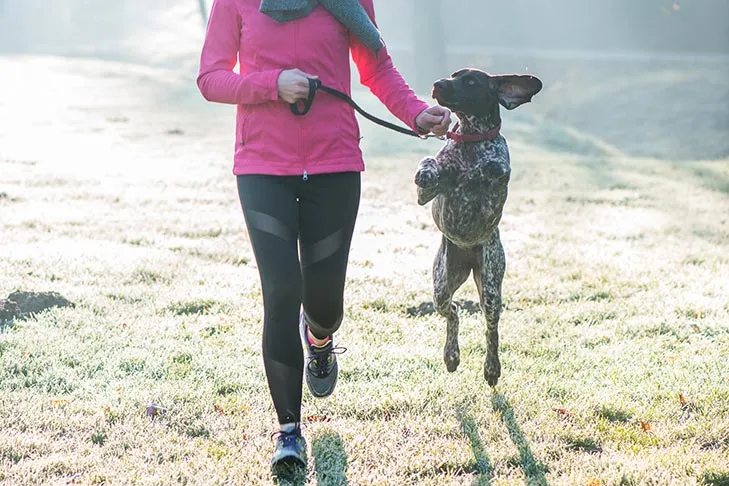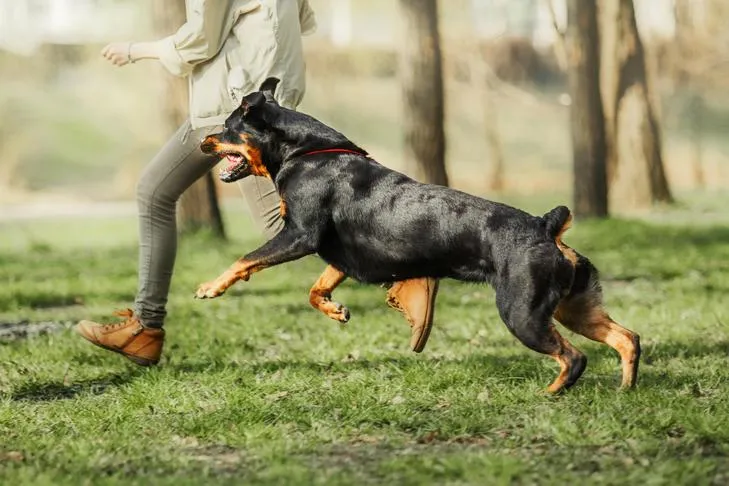Running with your dog offers a fantastic way to deepen your bond, keep both of you physically active, and significantly boost motivation for your fitness goals. Integrating canine fitness into your routine is vital for overall health. However, before embarking on this rewarding journey, it’s crucial to understand the proper steps and precautions involved in How To Train A Dog To Run With You to ensure a safe and enjoyable experience for both of you.
Choosing the Right Canine Running Partner
Not all dogs are built for long-distance running, and age plays a critical role in their suitability. It’s generally unsafe for puppies to engage in strenuous running due to their still-developing bones; most breeds should be at least 1.5 years old before starting a running program. Beyond age, individual temperament and breed characteristics are key factors. Some dogs naturally embrace running more enthusiastically than others. Take time to research your dog’s breed and consult your veterinarian for a thorough physical checkup to confirm that running is a safe and appropriate activity for their specific health and physical condition.
 German Shorthaired Pointer running with a woman in the early morning.
German Shorthaired Pointer running with a woman in the early morning.
Mastering Loose-Leash Walking: The Foundation
Before you can effectively teach your dog to run beside you, they must first master loose-leash walking. A dog that constantly pulls on the leash is merely frustrating at a walking pace, but it can become genuinely dangerous when you increase your speed. Remember, the outdoor environment is rich with distractions and rewards, from intriguing smells to darting squirrels. To maintain your dog’s focus and ensure the leash remains slack, you must be an equally compelling source of reinforcement. Utilize high-value treats, engaging toys, and enthusiastic praise to reward your dog whenever they keep the leash in a relaxed “J” shape.
A fundamental aspect of running together is teaching your dog to stay consistently on one side. If they weave in front of you or dart from side to side, they can easily trip you or tangle your legs in the leash, posing a significant safety hazard. The specific side you choose (left or right) is less important than sticking to it consistently. Begin this training at a walking pace, focusing on precise reward placement. Always offer treats and praise in the exact position you want to reinforce. For instance, if you want your dog on your left, only offer rewards when they are positioned correctly at your left leg. Once they have reliably learned one side, you can introduce a different cue to train them for the other side if desired. This disciplined approach is essential to stop dog from running out front door unexpectedly. A hands-free dog leash can be a valuable tool to enhance your control and comfort during runs. Consistency in this training also helps to stop dog running out door in general, reinforcing good habits even beyond your runs.
Teaching Speed Cues
Once your dog reliably walks politely by your side, it’s time to introduce cues that communicate changes in pace. While a cue like “let’s go” is useful for indicating a general walking pace, a distinct command such as “get running” or “move it” can signal that it’s time to pick up speed. The more precise information you provide your dog about your expectations, the more adept they will become at responding appropriately to your commands.
To effectively teach these running cues, integrate short bursts of jogging or running into your regular walks. Issue the chosen cue immediately before you accelerate, and then promptly reward your dog when they adjust their pace to keep up with you. Similarly, you can teach a distinct cue like “whoa” to signal a slowdown or a complete stop. Clear and consistent communication is key to a harmonious running partnership.
 Rottweiler running in the park playing with its owner.
Rottweiler running in the park playing with its owner.
Building Your Dog’s Running Endurance
With your dog now understanding how to maintain pace and position, the next step is to gradually build their physical endurance and get them into optimal running shape. Much like humans, dogs require a slow and progressive conditioning program to develop strength and stamina without risking injury. Begin by incorporating short, manageable stretches of running into your daily walks. Over subsequent outings, systematically increase the duration of your running segments while simultaneously reducing the time spent walking. Through this consistent, incremental approach over several weeks, your dog will progressively adapt and build the necessary endurance for longer distances. This careful progression is vital when you train a dog to run with you safely.
Essential Tips for a Safe and Enjoyable Run
Even after your dog is well-trained and conditioned for running, ongoing attention to their safety and enjoyment is paramount. Always start your runs with a brief warm-up, such as several minutes of walking, and conclude with a similar cool-down period. Be acutely aware of prevailing weather conditions; dogs are far more susceptible to heat and humidity than humans. On every run, carry an ample supply of water and offer it to your dog frequently to ensure they remain hydrated. Regular breaks are also important, allowing your dog to rest, relieve themselves, and explore their surroundings.
Off-leash running should only be considered in safe, legally designated areas, and only if your dog possesses a highly reliable recall amidst potential distractions. Throughout your run, observe your dog closely for any signs of fatigue or discomfort, such as excessive panting, lagging behind, or seeking shade. Dogs often strive to please their owners and may push themselves even when they need to stop. Knowing how to train your dog to run next to you safely also means knowing when to stop.
 Beagle on a leash running with a woman on a trail.
Beagle on a leash running with a woman on a trail.
Conditioning for Extreme Weather
For dedicated runners, challenging weather is often part of the routine. However, there are times when outdoor conditions—be it extreme cold, scorching heat, or heavy rain—are simply too severe and unsafe for your dog. During such periods, it’s essential to maintain your dog’s physical conditioning through indoor exercise alternatives. Depending on your dog’s size, a spirited game of fetch down a long hallway or up and down a carpeted staircase can effectively elevate their heart rate and engage their muscles. You can also create a fun obstacle course using household items like hula hoops or cardboard boxes. Many specialized training facilities also offer indoor agility classes, providing an excellent environment for your dog to run, jump, and burn energy safely indoors.
Furthermore, many dogs can be successfully trained to use a treadmill. While specialized dog treadmills exist, your own human treadmill can also suffice, provided the running surface is long enough for your dog’s stride. Larger dogs naturally require longer treadmills. Although treadmill training can be a convenient indoor workout, it’s not as simple as placing your dog on the machine and pressing start. Thoroughly research treadmill training techniques or consult a professional dog trainer to ensure your dog learns to use the machine safely and enjoys the experience. Crucially, never tie your dog to the treadmill or leave them unsupervised while it is in operation.
Conclusion
Training your dog to be your running companion is a deeply rewarding endeavor that fosters health, discipline, and a stronger bond between you. By carefully considering their breed and age, mastering loose-leash walking, teaching precise speed cues, and gradually building their endurance, you lay the foundation for a successful partnership. Always prioritize safety by observing weather conditions, ensuring hydration, taking breaks, and recognizing signs of fatigue. Even when outdoor conditions are prohibitive, creative indoor conditioning can keep your canine athlete in peak form. With patience, consistency, and a focus on your dog’s well-being, you’ll soon be enjoying many happy miles together. If you ever encounter challenges, don’t hesitate to consult with a professional dog trainer or your veterinarian for personalized guidance.
